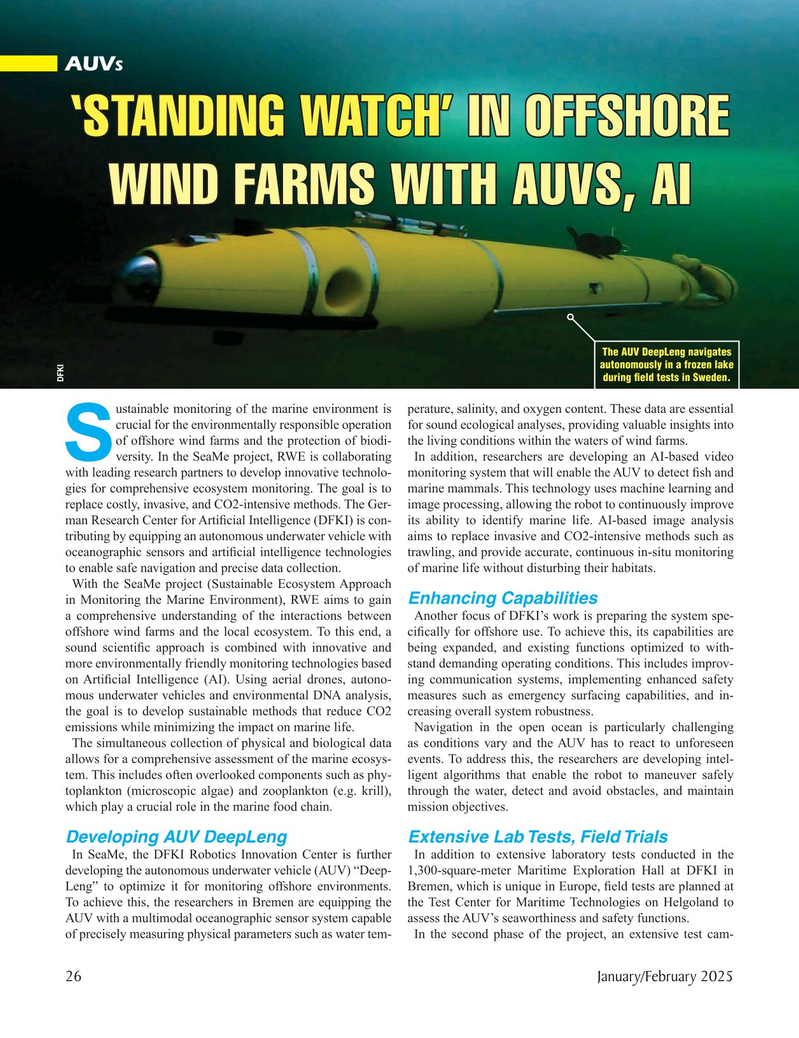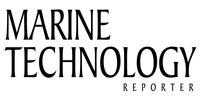
Page 26: of Marine Technology Magazine (January 2025)
Read this page in Pdf, Flash or Html5 edition of January 2025 Marine Technology Magazine
AUVS ‘STANDING WATCH’ IN OFFSHORE
WIND FARMS WITH AUVS, AI
The AUV DeepLeng navigates autonomously in a frozen lake during ? eld tests in Sweden.
DFKI ustainable monitoring of the marine environment is perature, salinity, and oxygen content. These data are essential crucial for the environmentally responsible operation for sound ecological analyses, providing valuable insights into of offshore wind farms and the protection of biodi- the living conditions within the waters of wind farms.
Sversity. In the SeaMe project, RWE is collaborating In addition, researchers are developing an AI-based video with leading research partners to develop innovative technolo- monitoring system that will enable the AUV to detect ? sh and gies for comprehensive ecosystem monitoring. The goal is to marine mammals. This technology uses machine learning and replace costly, invasive, and CO2-intensive methods. The Ger- image processing, allowing the robot to continuously improve man Research Center for Arti? cial Intelligence (DFKI) is con- its ability to identify marine life. AI-based image analysis tributing by equipping an autonomous underwater vehicle with aims to replace invasive and CO2-intensive methods such as oceanographic sensors and arti? cial intelligence technologies trawling, and provide accurate, continuous in-situ monitoring to enable safe navigation and precise data collection. of marine life without disturbing their habitats.
With the SeaMe project (Sustainable Ecosystem Approach in Monitoring the Marine Environment), RWE aims to gain Enhancing Capabilities a comprehensive understanding of the interactions between Another focus of DFKI’s work is preparing the system spe- offshore wind farms and the local ecosystem. To this end, a ci? cally for offshore use. To achieve this, its capabilities are sound scienti? c approach is combined with innovative and being expanded, and existing functions optimized to with- more environmentally friendly monitoring technologies based stand demanding operating conditions. This includes improv- on Arti? cial Intelligence (AI). Using aerial drones, autono- ing communication systems, implementing enhanced safety mous underwater vehicles and environmental DNA analysis, measures such as emergency surfacing capabilities, and in- the goal is to develop sustainable methods that reduce CO2 creasing overall system robustness.
emissions while minimizing the impact on marine life. Navigation in the open ocean is particularly challenging
The simultaneous collection of physical and biological data as conditions vary and the AUV has to react to unforeseen allows for a comprehensive assessment of the marine ecosys- events. To address this, the researchers are developing intel- tem. This includes often overlooked components such as phy- ligent algorithms that enable the robot to maneuver safely toplankton (microscopic algae) and zooplankton (e.g. krill), through the water, detect and avoid obstacles, and maintain which play a crucial role in the marine food chain. mission objectives.
Developing AUV DeepLeng Extensive Lab Tests, Field Trials
In SeaMe, the DFKI Robotics Innovation Center is further In addition to extensive laboratory tests conducted in the developing the autonomous underwater vehicle (AUV) “Deep- 1,300-square-meter Maritime Exploration Hall at DFKI in
Leng” to optimize it for monitoring offshore environments. Bremen, which is unique in Europe, ? eld tests are planned at
To achieve this, the researchers in Bremen are equipping the the Test Center for Maritime Technologies on Helgoland to
AUV with a multimodal oceanographic sensor system capable assess the AUV’s seaworthiness and safety functions.
of precisely measuring physical parameters such as water tem- In the second phase of the project, an extensive test cam- 26 January/February 2025
MTR #1 (18-33).indd 26 2/3/2025 9:55:52 AM

 25
25

 27
27
